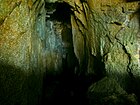Talk:Piper's Hole
| This article is rated Start-class on Wikipedia's content assessment scale. It is of interest to the following WikiProjects: | |||||||||||||||||||||||||
| |||||||||||||||||||||||||
A fact from Piper's Hole appeared on Wikipedia's Main Page in the Did you know column on 3 June 2022 (check views). The text of the entry was as follows:
|
Did you know nomination
- The following is an archived discussion of the DYK nomination of the article below. Please do not modify this page. Subsequent comments should be made on the appropriate discussion page (such as this nomination's talk page, the article's talk page or Wikipedia talk:Did you know), unless there is consensus to re-open the discussion at this page. No further edits should be made to this page.
The result was: promoted by Theleekycauldron (talk) 20:27, 26 May 2022 (UTC)
( )
- ... that according to legend, Piper's Hole, Tresco, (pictured) is connected by a underground passage to Piper's Hole, St Mary's? Source: [1]
- ALT 1... that according to legend, dogs who traveled through a passage between Piper's Hole, Tresco (pictured) and Piper's Hole, St Mary's emerged minus their fur?
- Comment: Exempt from QPQ, less than 5 DYK credits
Created by HenryTemplo (talk). Self-nominated at 15:14, 1 May 2022 (UTC).
 Article creation date versus filing day okay. Article length just past the line at 1532 B (274 words) readable prose size. Article neutrality good, article is thoroughly footnoted (albeit a lot of the sources seem to be rehashes of the same basic points), no evident signs of copyvio. Image license seems okay. Hook length and neutrality and sourcing okay (most of the sources in the article attest to the legend). But hook interest is on the weak side. Why not come up with an alternate hook that describes the supposed fate of humans or animals that attempt to go from one or the other? Wasted Time R (talk) 23:34, 4 May 2022 (UTC)
Article creation date versus filing day okay. Article length just past the line at 1532 B (274 words) readable prose size. Article neutrality good, article is thoroughly footnoted (albeit a lot of the sources seem to be rehashes of the same basic points), no evident signs of copyvio. Image license seems okay. Hook length and neutrality and sourcing okay (most of the sources in the article attest to the legend). But hook interest is on the weak side. Why not come up with an alternate hook that describes the supposed fate of humans or animals that attempt to go from one or the other? Wasted Time R (talk) 23:34, 4 May 2022 (UTC)
- Thanks for the feedback, I'll draft up a alt hook. Enjoy your day! HenryTemplo (talk) 05:25, 5 May 2022 (UTC)
 Okay, ALT1 captures more interest, is longer but well within bounds at 159 B, nomination is good to go. (I added the pictured into it, like ALT0 had.) Wasted Time R (talk) 21:36, 5 May 2022 (UTC)
Okay, ALT1 captures more interest, is longer but well within bounds at 159 B, nomination is good to go. (I added the pictured into it, like ALT0 had.) Wasted Time R (talk) 21:36, 5 May 2022 (UTC)
- Thanks for the feedback, I'll draft up a alt hook. Enjoy your day! HenryTemplo (talk) 05:25, 5 May 2022 (UTC)
References
- ^ Drew, Samuel (1824). The History of Cornwall: From the Earlist Records and Traditions, to the Present Time. W. Penaluna. pp. 255–256.



